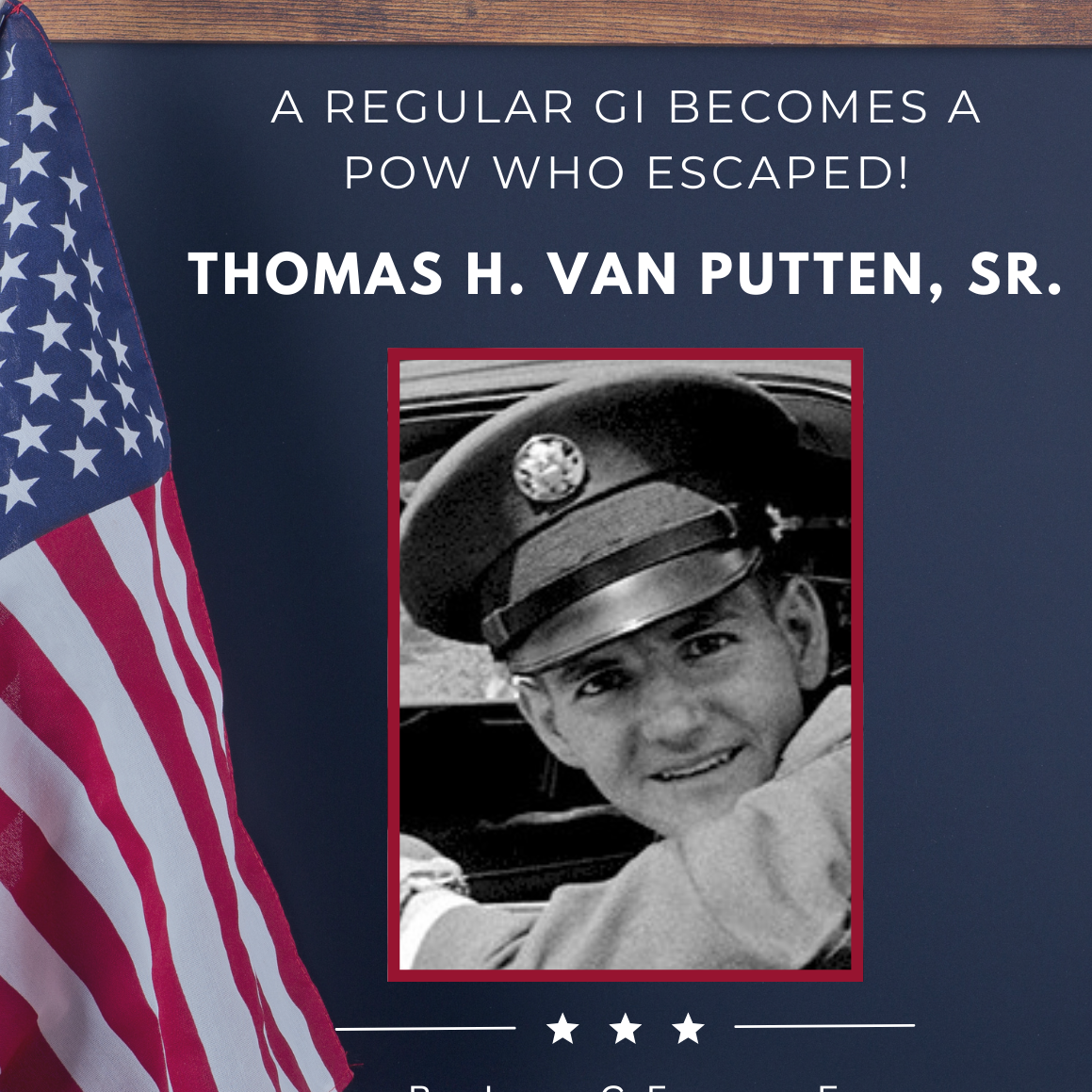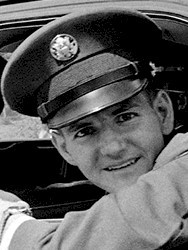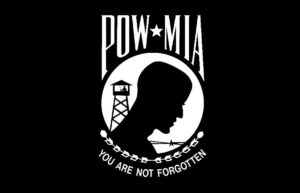Thomas Van Putten, Sr.
By James G. Fausone, Esq.

The Vietnam War shaped the lives of a generation. Thomas Van Putten, Sr. was one of those boys whose life was shaped by such outside forces. He is a reflection of so many regular men who were molded by the war but whose story is never told. Tom Van Putten's story is for all those ordinary guys whose stories are soon to be lost.
West Michigan Roots

State and local-area can be the largest influence on a person. Thomas Van Putten was born in Grand Rapids, Michigan on September 12, 1947. He grew up in Calendonia, just southeast of Grand Rapids in Michigan's lower peninsula. In the 1960s, Caledonia was a rural, small village with about 739 residents. That area of Michigan was popular and settled by many with Dutch heritage. The Van Putten name is a Dutch surname meaning "from Putten". Most often referred to the town Putten in Gelderland or the former island of Putten in South Holland.
Large numbers of people from the Netherlands began arriving in West Michigan as early as 1846. The first colony of those fleeing religious persecution was named Holland, Michigan, just west of Grand Rapids. The group formed a congregation of the Reformed Church of America, a Protestant denomination founded on Calvinist values. In 1857, some members of this group seceded to form the Christian Reformed Church.
Thousands of Dutch immigrants came to West Michigan in the decade or so after the first Holland settlement. Many of them were farmers who found a rich outlet for their skills in the area's welcoming soil. Throughout this period, Grand Rapids became known as a center for Dutch religious and cultural life in America. More than one-third of area residents claimed some Dutch ancestry in the 2000 census.
Thomas Van Putten came from good stock. He was surrounded by hard-working and religious people, the type that put God, Family, and Country as their priorities. Tom would have been exposed to heavy equipment on farms and factories that dominated the area. As a 19-year-old, Tom would have done his duty. He did not wait to be drafted into the Army; he joined up.
Enlisting & Assignment
He enlisted in the U.S. Army on September 15, 1966, and completed basic training at Fort Knox, Kentucky, in November of that same year. Pvt. Van Putten next attended advanced individual training as a construction machine operator at Fort Leonard Wood, Missouri, from November 1966 to January 1967, followed by service as a construction machine operator with the 362nd Engineer Company and with Company C of the 588th Engineer Battalion in South Vietnam starting in February 1967.
Movies are not made of the non-combatants' role in war. Books do not fly off the shelf telling stories of support roles in the military. But in reality, there is no warrior without cooks, mechanics, medical support, transportation, and combat engineers. The engineer's all-important role is to build bridges, runways, bases, buildings, and roads to support troops and their bases.
Van Putten's training at Fort Leonard Wood was part of a growing need the Army had for heavy equipment operators to work in the jungles of Vietnam. If you had experience or aptitude for such equipment, you were more valuable than just a rifle-toting grunt. Fort Leonard Wood was the home of the 6th Infantry Division. While the post was initially designated as an infantry division training area, Fort Leonard Wood quickly took on an engineer training mission. Soldiers went through a program that included both basic soldier and engineer skills. The training schedule varied from 8 to 14 weeks, depending on the need for engineer replacements. In time, engineer units were formed on the post and completed their training prior to moving overseas.
The unglamorous role of Army engineers was nonetheless vital to the war effort in Vietnam. They were responsible for a wide range of tasks, including:
- Building and maintaining roads, bridges, and airfields
- Clearing mines and booby traps
- Destroying enemy tunnels
- Providing support to combat units
- Conducting civic action projects
- Helping to rebuild the Vietnamese economy
- Destroying enemy tunnels and infrastructure
At their peak, there were over 40,000 Army engineers in Vietnam, supported by tens of thousands of contractors. The engineers were organized into a variety of units, including combat engineer battalions, construction battalions, and engineer support units.
The infrastructure they built and maintained made significant contributions to the war effort. They helped to keep the supply lines open, provided mobility for combat units, and protected soldiers from enemy attacks. Building this infrastructure out of a jungle that grew constantly and was subjected to monsoons was not an easy task.
Capture & POW Status

Mr. Van Putten was a 20-year-old construction machine operator with the Army's 79th Engineer Group when he was captured in February 1968 while helping build a Special Forces camp in Tay Ninh Province. Van Putten was on equipment transport that fateful February day. He was part of a convoy moving a couple of graders down a rough road to Katum Camp.
Katum Camp (also known as Katum Special Forces Camp or Firebase Katum) was a U.S. Army and Army of the Republic of Vietnam (ARVN) base northeast of Tây Ninh in southern Vietnam. The base was originally established to support Operation Junction City in February 1967 and the first US combat parachute jump for the war took place west of the camp. The base had an airfield and was near the Cambodian border and northwest of Saigon. The base received frequent artillery and mortar fire from the Viet Cong (VC) and People's Army of Vietnam (PAVN) leading it to be nicknamed Base Kaboom.
While the equipment convoy was traveling through a dense jungle on the limited roadway, it was stopped by 5 soldiers wearing South Vietnamese Army (SVA) uniforms and carrying M16s. Van Putten was riding security on top of one of the 209 Graders. He got down and attempted to converse with the soldiers. A mortar attack struck the other grader and fake SVA soldiers surrounded Van Putten and snatched him off the road and into the jungle. The immediate search by the convoy team was unfruitful as the jungle was so dense the Americans could not determine where the ambush team was headed. This story was told years later to Tom's son, Thomas Van Putten II (Tom II), by one of the men in the convoy.
Van Putten was captured during the Tet Offensive in early 1968. The Tet Offensive was a New Year Offensive by the VC and PAVN. This well-planned and surprising attack was an escalation in the war. The attack focused on major towns and areas to create political instability resulting in defections and rebellions. There were three phases of the offensive in 1968 from January to September. The shock of the early Tet Offensive caused the American public to really question the ability to win the war. By March 31, 1968, President Johnson announced he would not seek reelection for a second term as president. The U.S. troops were surprised by the January 1968 offensive and in phase one maybe 1000 U.S. soldiers went missing or were captured. The statistics from that period are hard to trust based on what has been subsequently learned about the reporting numbers. The capture of a grader operator highlights the chaos of war. Tom Van Putten was not someone who wrote a book, had a television show, nor a documentary or movie made about his capture.
A bit of the chaos was captured in the Department of Army "Valorous Unit Award" issued March 17, 1970, to the 588th Engineer Battalion and its attached units 104th Engineer Company (Dump Truck) and 362nd Engineer Company (Light Equipment). The award explains the Battalion and Companies were in Tay Ninh Province, "Assigned to upgrade main supply routes and construct critically needed airfields and Special Forces/Civilian Irregular Defense Group camps at Thien Ngon and Katum... As unit personnel aggressively attacked the cutting of the dense jungle undergrowth to prepare cleared areas large enough to set up their defensive positions and begin construction, they were subjected to constant concentrations of rocket, mortar, and small arms fire... they contributed immeasurably to the success of Operation Yellowstone."
Operation Yellowstone was conducted in the Province from December 1967 to February 1968. Northern Tây Ninh Province contained the largest People's Army of Vietnam (PAVN) and Viet Cong (VC) base areas in III Corps, providing easy access to bases in Cambodia, Saigon, and other cities in the Mekong Delta.
Escape & Recovery
Van Putten was one of about 1,500 other US servicemen captured and taken as a Prisoner of War (POW). His odyssey started on February 11, 1968. From the start, Tom Van Putten intended to get away from his captors. He explained to his son his three escape attempts. Attempt #1 was while marching to the Viet Cong camp. He started lagging behind four of the VCs hacking a trail, acting like he was injured and couldn't keep up. He then got past the VC soldier slipping into the jungle before heading back on the trail to the road where the Americas were. In a short time, he ran into another VC group who recaptured him and marched him to the POW camp that had a few other American prisoners.
The camp was rough with traditional huts, bamboo cages, and pits in the ground for punishment or torture. The food was barely enough to sustain life and consisted of maggot-infested rice. The men ate bugs they caught for extra nutrition. As the National Museum of the U.S. Air Force explains, "North Vietnam did not treat Americans as prisoners of war. Instead, they justified brutalizing POWs by claiming they were simply outlaws in an 'undeclared war.'"
Torture was Common
"North Vietnamese brutally and systematically tortured American prisoners to force them to confess to war crimes and participate in staged propaganda activities, or to try to get military information. Prisoners did their best to avoid cooperating, but torture can push people beyond the limits of human endurance. Some POWs learned that any answer, even a false or misleading one, could end their unbelievable pain temporarily. Many felt guilty about giving any answers at all, but submitted as little as possible while preserving their lives. North Vietnamese torture was exceptionally cruel - prison guards bound POWs' arms and legs with tight ropes and then dislocated them, and left men in iron footstocks for days or weeks. Extreme beatings were common, many times resulting in POW deaths."
Putten told of having shoulder bindings, knees bashed with a water can, and pistols held to his head with threats of blowing his brains out. The threats included pulling the trigger with guards laughing seeing the fright it inflicted.
Two other prisoners, John Dunn and James "Jimmy" Michael Ray, were equally maltreated and planned to escape with Van Putten. They dug a tunnel system looking to escape under the fence line. This attempt was reported to the camp guards by a fourth American who was so broken he feared retribution. Naturally, after the attempt was uncovered; Van Putten, Dunn, and Ray suffered further torture and punishment.
When Van Putten finally escaped, he was able to report out the names of the American POWs that were in his camp. Two of his buddies were PFC James "Jimmy" M. Ray and 1LT. John G. Dunn. Both men were captured in March 1968 as their unit was clearing a road in Lam Dong Province. They were first taken to a POW camp in Cambodia but were regularly moved and spent time in the camp where Van Putten was a prisoner.
The fate of Jimmy Ray is clouded in mystery. He participated in several unsuccessful escape attempts resulting in punishment and torture. He was awarded the Silver Star for gallantry for these escape attempts and resulting torture. Van Putten reported him alive in April 1969. However, the Viet Cong claimed in summer 1969, Jimmy Ray became ill with malaria and reportedly died in November of that year at a detention camp in the northern Tay Ninh Province, Cambodia area. His remains have not been found. No American saw Ray's body and his family held out hope for years he was still alive, even after the war, somewhere in southeast Asia.
Jimmy Ray's Silver Star citation reads:
Staff Sergeant James M. Ray is awarded the Silver Star for conspicuous gallantry and intrepidity in action against an armed enemy while serving as a Prisoner of War in South Vietnam during the period July 1969. Sergeant Ray distinguished himself by attempting to escape from an enemy prison camp. He recognized that odds for success were slight and if he was recaptured he would receive severe torture, long periods of solitary confinement, and possible death by execution. Although he was recaptured, he maintained strong conviction in the Code of Conduct.
In June 1969, Sergeant Ray was punished for violation of camp regulations by being placed in double chains, one on each ankle. Then in July 1969 while en route to the latrine, he attempted to escape by assaulting a guard. At that time, he had a chain locked to each ankle and was carrying the excess chain in each hand. As he approached the guard sitting on a stool in the guard hooch, he suddenly stopped, dropped the chains, and hit the guard in the face with his fist, knocking him from the stool to the ground. He then reached and grabbed the guard's rifle and started to turn when he slipped and fell. As Sergeant Ray fell to the ground, the additional guard who unlocked him jumped on him, wrapping the chain around his neck and began beating him with his fist. The guard who had been knocked to the ground got up and started to kick and beat on Sergeant Ray. Then both guards wrapped Sergeant Ray in the chains and locked them and then threw him into his bunker. He was left overnight wrapped in the chains and the next day he was again secured to his bunker with two chains, one attached to each ankle. He was not allowed outside his bunker, and his rations were cut to one meal a day. Shortly after this, he was removed from the camp and was never seen again.
This extreme gallantry exhibited by Sergeant Ray was amply illustrated by the fact that so few prisoners ever tried to escape, primarily due to the rigid security measures imposed by the camp. This courageous escape attempt served more than to merely get him out of the prison camp. More guards were required, and prisoner morale soared. This act of gallantry, with recognition of the grave risk to his own life, demonstrated a great devotion to duty and his country, which reflected great credit upon himself and the United States Army.
POW John G. Dunn (Captain) had a long ordeal but a happier ending. He was wounded by a rocket-propelled grenade and then again by a hand grenade when captured, on March 18, 1968. After spending 1,792 days (almost 5 years) in captivity in South Vietnam and Cambodia, he was released during Operation Homecoming on February 12, 1973. Upon release, he continued to serve in the Army until November 1, 1988, when he retired as a Lieutenant Colonel.
John Dunn's Silver Star Citation reads:
Captain John G. Dunn, Military Intelligence, is awarded the Silver Star for heroism involving voluntary risk of life while serving as a Prisoner of War during May 1968. Ignoring international agreements on treatment of prisoners of war, the Viet Cong resorted to a routine of mental and physical cruelties including withholding of medical treatment and food, for the purpose of obtaining military information, biographical data, and propaganda material detrimental to the United States. During the latter part of May 1968, Captain Dunn was undergoing intense interrogation for the purpose of obtaining military information. Even though he was forced to live in a filthy pit, chained by the ankle like an animal, given only enough to eat to sustain life, severely beaten, and his life threatened, Captain Dunn would not give the requested information. After being refused food and water for three days, he still refused to give information. At midnight on the third day he was tied, blindfolded, taken to the jungle, placed on his knees and an AK-47 rifle placed to his head and told that he had 60 seconds in which to give them the desired information. At this time, he agreed to their demands, but gave them false and distorted information, hoping for enough time to regroup his thoughts. Instead, he was again given ten minutes to live and, again, he refused to give additional information. Shortly after this last threat, he was returned to his bunker and camp routine was restored. Despite extremely harsh conditions, he never wavered in his devotion and loyalty to God, country, and fellow prisoners. The heroism displayed by Captain Dunn reflects great credit upon himself, his family, and the United States Army.
These men were the POW brothers of Thomas Van Putten, Sr. After spending 412 days in captivity, SP5 Van Putten escaped from his captors on March 28, 1969, and made it to friendly faces on April 17, 1969.
This attempt was successful because of timing and stealth. A Vietnamese holiday was occurring, the Ho Chi Minh Communist Youth Union was celebrating its March 26, 1931 anniversary. The guards of the camp were celebrating heavily. Van Putten was told to shackle his own feet. He had previously secured a piece of twine and used it to tie the shackles together so it looked locked up. It was enough to fool the celebrating guard. He then waited for the guards to become further inebriated and slipped out of the camp. He told of his escape to his son, Tom II.
He had a general sense of direction from the camp to a river that he thought flowed to an area with American forces. He was in a dense jungle and progress was slow. His weight, health, and energy had so deteriorated that every hour was a struggle.
At one point, he was leaning, exhausted, against a tree. Inflicting further insult, the monkeys in the trees started throwing fruit at him. After frustration and anger subsided, he realized many of the fruits and nature that he did not know, had bites out of them. His brain, and growling stomach, grabbed onto the idea that if the monkeys could eat the fruit, he could too. Van Putten then collected as much fruit as he could carry and moved towards the river. He survived on that fruit and a single lizard he caught and ate.
The VC were searching for him and came within 5 feet of him one night while he was hiding in the jungle. As he made his way to the river, he floated downstream. He was exhausted at one point and stopped to rest on a sand bar in the river.
While on that sand bar, an Army helicopter crew from C Troop, 3d Squadron, 17th Air Cavalry, spotted him after 18 days. He began waving at the OH-6A Light Observation Helicopter (LOH) which was flying a visual reconnaissance mission in Tay Ninh Province. The pilot at first thought he was an enemy soldier. Van Putten was wearing traditional Vietnamese black pajamas. The copter crew was unsure if it was a trap by the VC. On a second pass, the crew realized the man on the sand bar had a full beard. He must be an American they decided. Van Putten was picked up in an area 12 miles northwest of Tay Ninh City.
According to WO1 Gary D. Gray (Ketchum, Oklahoma), pilot of the helicopter, "We weren't sure this wasn't a VC trick, so we took our time looking the man over before we went in for him." As soon as they were sure the man on the ground was an American, the Air Cav Pilots set the LOH down and picked up the wandering soldier. Van Putten had escaped from the VC early in April and had been roaming the jungle for nearly three weeks looking for friendly forces.
The LOH helicopter could only hold three men. The door gunner got out and loaded Van Putten. The armed gunner stayed on the sandbar and waited for them to return after dropping Van Putten off at base for medical attention.
Crew chief Wampler said, "When we sat down to pick him up, boy he was really rough looking. He jumped inside, grabbed me by the shoulders and said, 'I love you'". Then Van Putten said he was hungry and consumed the only food available, canned fruit.
Thomas Van Putten, Sr.'s Silver Star Citation reads:
Specialist Five Thomas H. Van Putten distinguished himself by outstanding gallantry in action on 28 March 1969 while a prisoner of the Viet Cong in South Vietnam. On 28 March 1969, after more than one year in a Viet Cong prison camp and after attempting to escape on two previous occasions, he was able to deceive his guard and slip unnoticed from the rear of his bunker into the thick jungle surrounding the POW Camp.
For 21 days, Specialist Van Putten utilized every bit of training he possessed, continuously evading the Viet Cong's attempts to recapture him, and narrowly missed being recaptured on two separate occasions. In one instance he placed his black colored underpants over his head for camouflage, and getting into the water, pulled himself along with his hands on the bottom of the stream to a position downstream and away from the enemy. Over the 21-day evasion period he survived on a lizard and a few pieces of sour fruit. Specialist Van Putten’s determination and internal fortitude were demonstrated by continuous movement toward what he believed to be friendly positions.
Upon recovery by United States forces he was so weak that he could only walk 15 or 20 feet at a time before blacking out and collapsing. Upon return to United States control, he sought to provide information in order to assist in the rescue and recovery of his comrades still in enemy hands.
Specialist Van Putten’s burning determination to escape, undiminished after two unsuccessful attempts, his clear-headedness in formulating an effective plan and his audacity in executing it successfully, reflect the highest credit on his professionalism and courage and are in keeping with the highest traditions of the military service.
When he landed in the United States, it was bittersweet. He was met by his parents who told him that his high school sweetheart, whom he had dated for 5 years, had married someone else shortly after he went MIA in February 1968. She wrote him the classic "Dear John" letter, but it was not delivered until he arrived in the States. He was briefly hospitalized for his injuries in the U.S. Naval Hospital at Great Lakes, Illinois, from April to July 1969. This was not far from his hometown which he visited upon recovery and received a hero's welcome.
Many POWs were quickly discharged from service; Tom, however, continued to serve. He had a limited amount of celebrity status that resulted in dinner at the White House with President Richard Nixon and the First Lady on May 30, 1973. For a West Michigan boy, and someone who survived on maggots, bugs, monkey fruit, and a lizard, a fancy White House dinner had to be surreal. Van Putten remained in the Army and served at bases both in Europe and the United States - mostly in construction, but he spent almost two years as a trainer with a Basic Training unit in Fort Ord, CA. Among other things, he taught escape and evade training. This was a testament to his skill set and determination not to be defined by captivity.
Tom understood the value of service and what he was giving to his country. He stayed in the Army for a total of 9 years. Somewhat unusual, proving the hardy constitution of this west Michigan boy, he stayed on active service for 6 years after escaping as a POW. The duties as a construction equipment operator and trainer suited him. The Army family that he had developed continued to strengthen him.
Return to West Michigan
As a 29-year-old with nine years in the service, Van Putten needed a good reason to get out. Tom had a good reason when he found the love of his life, Evelee Catherine Schug. Tom was introduced to Evelee by an aunt. That was a good reason to get out and settle down back in west Michigan. He received an honorable discharge from the Army on September 12, 1975. He was married in 1976 and they were partners in life until his death in October 2008, 32 years later. Tom adopted Evelee's two girls from another relationship and they had Thomas Van Putten, II in 1977.
He spent years working at Steelcase, which was one of the area's leading employers. Steelcase, Inc is an international manufacturer of furniture, seating, storage, desks, and office systems for offices, hospitals, classrooms, and industrial settings. It started in 1912 and is now a multi-billion dollar company traded on the New York Stock Exchange. This would have been a prime job for a veteran in Michigan. This was the kind of company from which the middle class grew. Tom and Evelee were able to raise a family on his income. They had three children and 10 grandchildren. Tom spent years working in Steelcase's mail room. However, his injuries limited his ability to work. He had trouble lifting packages above his shoulders and after standing for a period of time, he had legal and knee issues. Ultimately, Tom was medically retired because of disabilities and received a worker's compensation redemption.
The physical injuries were not the only problems he had. Tom had nightmares and PTSD. According to Tom II, his Dad all too often screamed when sleeping, lashed out and hit Evelee in his sleep, and would even choke her. His PTSD was severe when triggered, but the family coped without much outside support. Over time, he had surgery on his shoulders and femoral arteries and had a heart attack. After one of his surgeries, he came out of anesthesia flashing back to captivity and screaming for hours; "Jimmy, Jimmy, they cut me open" as if his old POW friend was in the room. Ultimately, poor circulation and blood clots resulted in his leg being amputated above the knee in 1990 when he was 43 years old. For the next 18 years, he wore a prosthetic leg or used a wheelchair. All too often the impacts of being a POW ripple through life and the loss of the leg can be traced back to complications stemming from injuries during captivity.
Tom remained passionate about fishing, hunting, and the fire service. He first joined the volunteer Saranac Fire Department. When the family moved, he joined the Lowell Fire Department. Even after his leg surgery, wearing a prosthetic, he would be the engine operator and ran the department's cadet program for 14-18-year-olds.
Tom II recalls his Dad as an avid fisherman, even after the surgery. He would fish all year long, including ice fishing when the lakes froze over. He introduced his Dad back into hunting by arranging for a quad track that would let him drive into the woods. Even when Tom II could not accompany his Dad, he would get a call to come assist Tom if he needed help retrieving the game. Tom was a skilled turkey and duck hunter. He was also known to put his boat in the water, backing down the boat ramp by himself if no one was available to go out with him. Like many veterans, he found peace and tranquility out in the woods and on the water.
Tom passed away at the age of 61 due to a heart attack. He was survived by Evelee for another three years before she joined him.
About the Author
Jim Fausone is a partner with Legal Help For Veterans, PLLC, with over twenty years of experience helping veterans apply for service-connected disability benefits and starting their claims, appealing VA decisions, and filing claims for an increased disability rating so veterans can receive a higher level of benefits.
If you were denied service connection or benefits for any service-connected disease, our firm can help. We can also put you and your family in touch with other critical resources to ensure you receive the treatment you deserve.
Give us a call at (800) 693-4800 or visit us online at www.LegalHelpForVeterans.com.
This electronic book is available for free download and printing from www.homeofheroes.com. You may print and distribute in quantity for all non-profit, and educational purposes.
Copyright © 2018 by Legal Help for Veterans, PLLC
ALL RIGHTS RESERVED



